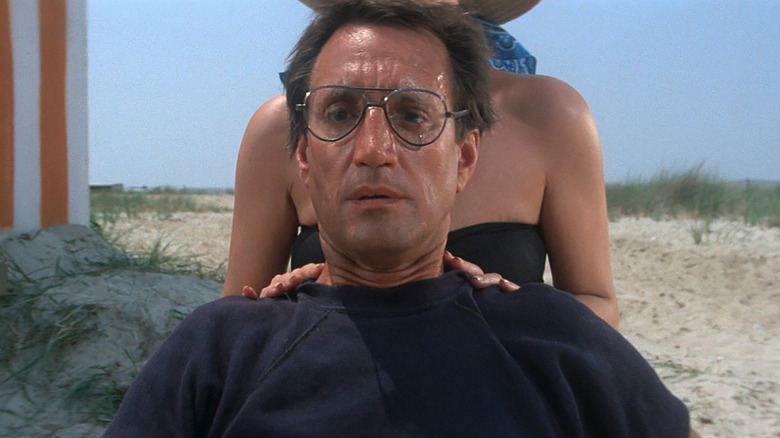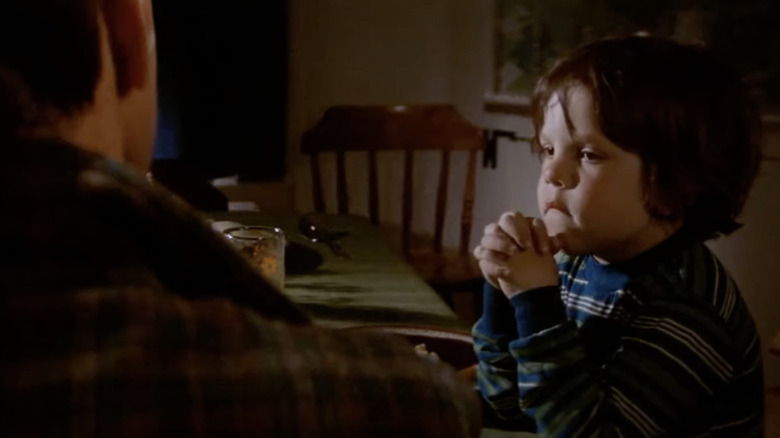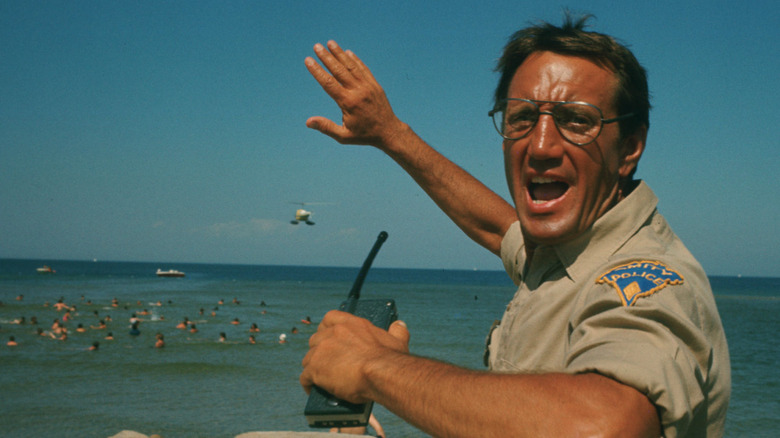Jaws Did More Than Scare Audiences – It Taught Them How To Watch Movies
Every July 4th weekend, I, like so many others, uphold a sacred tradition: watching "Jaws." It's seasonal, it's timeless, and frankly, watching a fictional town be terrorized by the inaction of a local government that cares more about profits than people is one of the few appropriate ways to "celebrate" American independence. At the center of "Jaws," and the source of multiple generations developing galeophobia, is a large, aggressive, great white shark. The success of the film (released on June 20, 1975) invented the summer blockbuster, and 50 years later, the combination of Bruce's dorsal fin breaking the surface of the water and the resonant rumble of a John Williams-conducted tuba is enough to keep some people out of the water for good.
Like its notorious antagonist gliding into the waters off Amity Island, "Jaws" was a cinematic feeding frenzy that continued well beyond Labor Day. This wasn't just a movie; it was a moment, and cinema would never be the same. A masterpiece of suspense that birthed the legacy of Steven Spielberg, "Jaws" redefined what was possible to achieve for a "summer movie," and it also completely changed the relationship audiences had with the movies. Cinema has always been commenting on and continuing a conversation with the hopes, dreams, fears, and social anxieties of its time, but the audiences themselves weren't always having the conversations among one another. And if they were, it certainly wasn't on the scale that "Jaws" inspired.
"Jaws" has become a permanent fixture in American culture and has permeated the very language of cinema. Its popularity and evergreen messaging allow it to exist at a strange junction of myth and modernity, art and commerce, horror and history. It was a shark movie, yes, but it was also an examination of the troubling realities of American life. A politician disregarding safety for some extra tourism revenue, a coroner pressured to peddle lies to support that politician, and a scientist pleading for people to heed his warnings are foundational to the film's message. The shark is not the worst thing plaguing Amity Island, and the audience knows that.
Simply put, when it comes to "Jaws," it really is that deep, and audiences loved diving into those waters.
Jaws taught general, mainstream public how to watch movies
The popularity of "Jaws" led to a frenzy of rip-offs. The film's structure was so effective, it inspired plenty of films to try and replicate it. Much has been said (and will continue to be said until the sun burns out) about the slasher-esque opening, the now-iconic dolly pull, Quint's all-timer of a monologue, and the excitement of the final sharksplosion, but the reason these thrilling elements work as well as they do is because they're nestled in the fabric of the everyday lives of people working in a quaint, seaside town. The horror of "Jaws" is effective because it exists in a film that resembles a world the audience is acquainted with.
It's most evident in scenes with Chief Brody (Roy Scheider) and his family, especially when his son Sean (Jay Mello) is mimicking him at the dinner table. These small moments, which would become crucial to Spielberg's filmography moving forward, had far more in common with the work of 1970s auteurs like Robert Altman than the previous year's big blockbuster, John Guillermin's "The Towering Inferno." Because "Jaws" famously waits as long as it does to show the shark in its entirety, it forces the audience's imagination to do much of the heavy lifting. We become so desperate for an escape from the hundreds of horrifying assumptions bouncing around in our noggins that we allow ourselves to fall into the scenes that feel safe and familiar, and fall in love with the characters that remind us of people we know in our own lives.
Four-quadrant audiences started to engage with popular films on a deeper, more intimate level. Films were no longer treated by the general public as passive entertainment, but as art to actively engage with. The lasting psychological association between "the sea" and "danger" is the most obvious, but when just about everyone on the planet has a shared reference for pop culture literacy, it inspires even casual film fans to start looking for those opportunities within other films. It could be argued that without the interactive, attentive, moviegoing culture that "Jaws" helped usher into the mainstream, a film like "Star Wars" doesn't become the lasting phenomenon it became.
The impact of Jaws goes beyond changing the release landscape
The way the financial success of "Jaws" (and a majority of the director's subsequent films) helped make Steven Spielberg the highest-grossing director of all time and completely changed the way Hollywood scheduled film releases cannot be overstated. Less appreciated, though, is the way "Jaws" fundamentally changed the way general, mainstream audiences consumed media. By inviting viewers to think critically about what wasn't shown on screen, and assess for themselves why the film was so effective, "Jaws" wasn't just a film to be watched — it became one to be experienced, dissected, debated, and referenced in everyday life. In doing so, "Jaws" taught audiences how to flex their analytical muscles and inspired them to continually look for the story within the story of the movies that they watched. "Star Wars" wasn't just a space opera with some fight scenes; it was a hero's journey where a farmboy helped a rebellion of freedom fighters take down a tyrannical Empire.
The academic landscape of film theory gained serious momentum in the late 1970s and early 1980s. Film criticism had been a prominent aspect of the industry since the 1940s, but the general public gained a greater interest in the late 1970s, ushered in by Roger Ebert and Gene Siskel's PBS series "Sneak Previews." Audiences wanted to learn more about the films they were seeing and hear about differing interpretations of the same text. "Jaws" is often cited as the spark that lit the flame of "event movies," but the "event" goes far beyond a film's runtime in the hallowed halls of a movie theater. It's why so much of the film's messaging continues to resonate after all these years (memes of Mayor Larry Vaughn are still shared whenever politicians favor optics over material safety). Entertainment absolutely has the power to influence public opinion, as fictional narratives can blur into real-life beliefs. Developing a strong sense of media literacy is key, and "Jaws" was instrumental in helping audiences recognize that.
A shared emotional experience is central to maintaining audience engagement, and by incorporating that into the story, "Jaws" influenced how people connect with cinematic narratives forever. As media literacy rates decline and blockbuster cinema continues pumping out sanitized, unchallenging material to the masses, it's crucial to remember that history has already proven that audiences don't want mindless entertainment. They want to be nourished.


